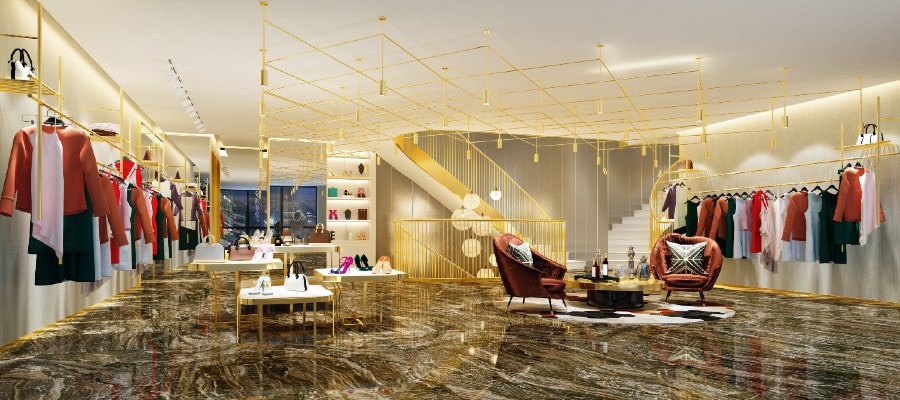Retail & Distribution
High Tech Boosts High-Touch Luxury Services
3 juni 2019

Stores in this elite sector have carefully constructed footprints. Some are nearly museum-like in appearance, with meticulously curated artwork gracing their interiors. Others house restaurants, coffee shops, book shops and even movie theaters. They’re designed to be comfortable and inviting, whether a client simply wants to peruse the newest collections or choose the right outfit for an upcoming event while shopping with their children and friends.
In this highly competitive market, special services enable luxury retailers to deliver the ultimate in-store experience and set themselves apart from the competition.
Three trends emerged as the most positive for the growth of luxury insiders’ businesses: product and service innovation, social media and rise of the digital world, and product/service diversification.
Luxury Daily, State of Luxury 2018
Technology has become a key asset in this area — both in customer-facing roles as well as behind the scenes. With the right solutions in place, luxury brands can provide customers with easy access to the special services most valuable to them, while also empowering sales associates to better personalize the suite of services to each client’s preferences and expectations.
Next-gen stores are about more than products, they are about experiences – trying products, taking part in events, receiving services. It’s click-and-collect, but it’s also accessing inventory in other locations, virtually connecting stores with offsite experts or talent or sharing who-wore-it-best posts.
Just as display windows are intended to charm and enchant luxury buyers — bringing them into the store, where associates can tell the brand’s story and deepen the customer relationship — digital channels should also be focused on extending the in-store experience with services that maintain engagement and drive face-to-face interactions. Savvy retailers know technology can help deliver value-added omnichannel services and boost the brand’s reputation for service before the client even enters the store.
Customers may want to use their computer or mobile device to book an in-store appointment for a private room, where they can meet with their personal shopper or other associates and conduct their visit without disruptions. If dining options are available, clients often prefer to place meal orders ahead of time. Others might want to reserve a seat in the store’s movie theater or have their favorite hot (or cold) beverage waiting for them upon arrival. The convenience of making these booking and reservation services available through a web site or mobile app resonates with today’s connected buyer. It also provides retailers with more touch points to build on the customer relationship.
When in the store, carefully deployed technology makes the brand’s special services available without impeding the customer’s shopping journey. For example, the data contained in buyers’ profiles will show if they’ve had items altered or customized in the past, potentially pointing toward the need for a tailor or seamstress to be on hand during the visit. That personalization can even carry over to the in-store checkout, where technology makes it possible to create a shopping bag marked with a customer’s name or initials to fit his or her unique needs.
If the shopper has children, then gadgets to keep them entertained — tablets, gaming systems, music players — can be ready. Child care services are also an option within many stores, making it even more important for sales associates to have discreet access to the client’s profile, so that they can quickly arrange for those support services that will make the visit pleasant and leisurely.
For today’s affluent consumers, the physical brand experience extends beyond the store’s walls. Technology is the bridge that allows retailers to maintain and cultivate everywhere, any time engagement. Customers often enjoy sharing the highlights of their in-store visits — whether it’s a shopping trip or an invitation-only party hosted by their favorite designer — on social media. Others want to connect with experts, such as stylists and artisans, who may not be present in the store but can assist in the shopping journey. With technology powering an omnichannel strategy, the brand can share in all of those online discussions — and the exposure.
Another valuable benefit of the right technology solution is the ability to quickly access real-time inventory data to find any item the customer desires. Is their size or preferred color available in-store? If not, the sales assistant can find it wherever it is in the retailer’s network and with a few taps can send it on its way to the client’s choice of delivery locations.
As items are selected for purchase, the right technology helps to seamlessly move luxury shoppers from selection to payment. Rather than waiting in line to pay, brands can offer the option to bill a credit card already on account or send an invoice at the end of the month to cover recent purchases. If the client prefers to pay in-store, back-end systems should be integrated so that items from multiple departments can be consolidated, resulting in only one wait in line at the register.
Post-sale support, when done right, is instrumental in extending the customer relationship and improving satisfaction and retention. Will a client who needed a ring resized or a watch fixed prefer to get a phone call, an email or a text message when the item is ready? Attentive sales associates will want to use the customer’s favored platform, and by including this information in the buyer’s profile, the value of the brand experience can be reinforced during their next transaction.
Equally important is the ability to deliver exemplary services across the entire brand footprint. Luxury buyers may frequent numerous stores in their home region while also dropping into far-flung brick-and-mortar locations during their travels. A best-in-class technology suite provides sales associates with the latest customer information, so the right mix of services and support can be delivered at just the right time in the buying journey — no matter if the transactions occur online, in a customer’s home town or anywhere across the globe.
ebook
In the Luxury Universe: Focus on Global Proximity, Service and Selling Ceremony


